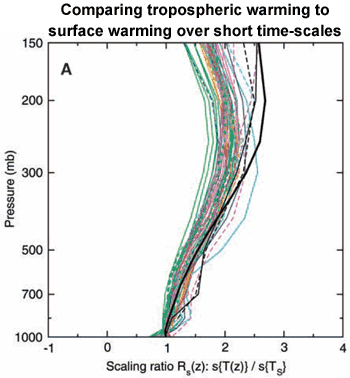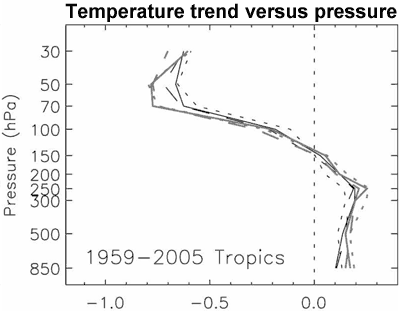How Jo Nova doesn't get the tropospheric hot spot
Posted on 19 June 2010 by John Cook
Climate models predict that during global warming, the lower atmosphere in the tropics should warm faster than the surface. This phenomenon has been coined the 'tropospheric hot spot'. Unfortunately, that elusive hot spot has been devilishly hard to measure. Both satellites and weather balloons have previously found the warming trend in the tropical troposphere is roughly the same as (or even less than) surface warming. The Skeptics Handbook, published by Jo Nova, labels this a "knockout blow" to human caused global warming.
The biggest misunderstanding about the tropospheric hot spot is the mistaken notion that it's caused by the greenhouse effect. Jo Nova leads with the headline "The greenhouse effect is missing" and refers to the "telltale warming pattern that greenhouse gases would leave". However, the hot spot is not caused by the greenhouse effect. In fact, we expect to see an amplified warming trend in the troposphere no matter what's causing the warming.
The hotspot is actually due to a basic law of physics called the moist adiabatic lapse rate. As air rises to higher altitudes, it cools. When the water vapor in the air cools enough to condense, latent heat is released - this partly offsets the cooling. In the tropics where the air is more moist, more heat is released. The result is we expect to see magnified warming trends in the troposphere compared to the surface, both over short intervals (say months to a year) and long intervals (over decades). Indeed over short periods, observations are consistent with expectations - a tropical hot spot:

Figure 1: Ratio between atmospheric temperature compared surface temperature at different altitudes. Colour lines are various model results. Thick black line is theoretical value. Thin black line is weather balloon measurements from RATPAC. Dashed line is weather balloon measurements from HadAT2 (Santer 2005).
So short-term trends confirm the moist adiabatic lapse rate. However, when we look at long-term trends, satellites and weather balloons have trouble detecting the magnified trend. Why? A likely answer is measurement uncertainty. Satellite measurements are subject to long-term biases caused by orbital decay and the cooling stratosphere. Weather balloon data comes with it's own host of uncertainties. We have few balloon measurements in the tropics, there's been many changes of instruments and there are known biases due to solar heating. A number of teams have used different techniques to account for the biases affecting weather balloon data. The various methods find a similar result - when the biases are adjusted for, the result is closer to the expected moist adiabatic amplification (Titchner 2009, Sherwood 2008, Haimberger 2008).

Figure 2: Bias-corrected weather balloon temperature trend vs pressure over the tropics from 1959 to 2005 (Sherwood 2008).
Independent evidence for the hot spot comes from measurements of wind trends, which aren't subject to the same biases as weather balloon temperature measurements. As there's a direct relationship between temperature gradients and wind shear, this allows calculation of temperature trends from wind data. What is found is a peak warmer trend in the upper troposphere, consistent with climate model simulations (Allen 2008).
That's not to say everything is hunky dory with tropospheric trends. Satellites still show tropospheric trends less than expected, although the RSS trend is broadly consistent with expectations. And there is still much uncertainty in the weather balloon data.
Nevertheless, there are several key points to remember. Detecting the tropospheric hot spot is not a test of the greenhouse effect but of the moist adiabatic lapse rate. Data uncertainty and long-term biases mean detection of the hot spot has been difficult. Nevertheless, there is evidence that the hot spot exists. But if you cannot accept this evidence, to be strictly correct, what you are is a moist adiabatic lapse rate skeptic.































 Arguments
Arguments























 0
0  0
0 Because of this connection it is quite common to consider the WV+LR feedback collectively. So the hotspot is indeed due to the moist adiabat, and the lack of such amplification is neither a disproof of anthropogenic global warming, nor is an argument against a high sensitivity.
In some exotic cases, it is conceivable that greenhouse gases themselves can alter the thermal structure of the atmosphere in such a way as to produce a large reduction to the greenhouse effect in condensation. This might happen for example in an atmosphere that was strongly absorbing to incoming solar radiation. If you replace radiation at incident at the surface with radiation absorbed aloft, you can generate an anti-greenhouse effect and make a deep layer that is nearly isothermal. It is thought that if the ratio of methane to CO2 concentrations approaches one, you can get a "haze layer" that absorbs solar radiation in the upper atmosphere and radiates it back to space, whilst cooling the surface. This has implications for early Earth evolution. In the modern however, water vapor does absorb some solar radiation and is dominant in the lower atmosphere where humidity is greatest and the polar regions where you have a good chance of absorbing upwelling photons from high albedo. This shortwave component of the water vapor feedback is positive by causing an increase in shortwave absorption and accounts for about 15% of the total water vapor feedback.
Because of this connection it is quite common to consider the WV+LR feedback collectively. So the hotspot is indeed due to the moist adiabat, and the lack of such amplification is neither a disproof of anthropogenic global warming, nor is an argument against a high sensitivity.
In some exotic cases, it is conceivable that greenhouse gases themselves can alter the thermal structure of the atmosphere in such a way as to produce a large reduction to the greenhouse effect in condensation. This might happen for example in an atmosphere that was strongly absorbing to incoming solar radiation. If you replace radiation at incident at the surface with radiation absorbed aloft, you can generate an anti-greenhouse effect and make a deep layer that is nearly isothermal. It is thought that if the ratio of methane to CO2 concentrations approaches one, you can get a "haze layer" that absorbs solar radiation in the upper atmosphere and radiates it back to space, whilst cooling the surface. This has implications for early Earth evolution. In the modern however, water vapor does absorb some solar radiation and is dominant in the lower atmosphere where humidity is greatest and the polar regions where you have a good chance of absorbing upwelling photons from high albedo. This shortwave component of the water vapor feedback is positive by causing an increase in shortwave absorption and accounts for about 15% of the total water vapor feedback.







Comments